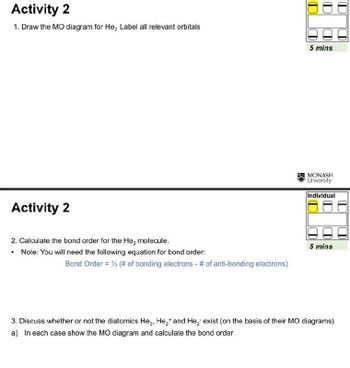
Chemistry: The Molecular Science
5th Edition
ISBN: 9781285199047
Author: John W. Moore, Conrad L. Stanitski
Publisher: Cengage Learning
expand_more
expand_more
format_list_bulleted
Question
help please answer in text form with proper workings and explanation for each and every part and steps with concept and introduction no AI no copy paste remember answer must be in proper format with all working

Transcribed Image Text:Activity 2
1. Draw the MO diagram for He, Label all relevant orbitals
Activity 2
5 mins
MONASH
University
Individual
2. Calculate the bond order for the He₂ molecule.
5 mins
.
Note: You will need the following equation for bond order:
Bond Order = ½ (# of bonding electrons - # of anti-bonding electrons)
3. Discuss whether or not the diatomics He₂, He2+ and He₂ exist (on the basis of their MO diagrams)
a) In each case show the MO diagram and calculate the bond order
Expert Solution
This question has been solved!
Explore an expertly crafted, step-by-step solution for a thorough understanding of key concepts.
Step by stepSolved in 2 steps with 3 images

Knowledge Booster
Similar questions
- The molecular orbital diagram of NO shown in Figure 10.47 also applies to OF. Draw the complete molecular orbital diagram for OF. What is the OF bond order? Figure 10.47 Molecular orbital diagram for nitric oxide (NO). The molecular orbital diagram for NO predicts a bond order of 2.5 and predicts that the molecule is paramagnetic with one unpaired electron. These predictions are verified by experimental measurements.arrow_forwardDiscuss the nature of the bonding in the nitrite ion (NO2) . Draw the possible Lewis resonance diagrams for this ion. Use the VSEPR theory to determine the steric number, the hybridization of the central nitrogen atom, and the geometry of the ion. Show how the use of resonance structures can be avoided by introducing a de-localized MO. What bond order does the MO model predict for the NO bonds in the nitrite ion?arrow_forwardThe bond dissociation energies for the species NO, CF , and CF+ are ordered as CF+NOCF . Use MO theory to explain this ordering.arrow_forward
- For each of the electron configurations in Problem 22, determine whether the molecule or molecular ion is paramagnetic or diamagnetic.arrow_forwardThe molecular orbital diagram of NO shown in Figure 10.47 also applies to the following species. Write the molecular orbital electron configuration of each, indicating the bond order and the number of unpaired electrons. (a) LiBe+ (b) CO+ (c) CN (d) OF Figure 10.47 Molecular orbital diagram for nitric oxide (NO). The molecular orbital diagram for NO predicts a bond order of 2.5 and predicts that the molecule is paramagnetic with one unpaired electron. These predictions are verified by experimental measurements.arrow_forwardThe molecular orbital diagram of NO shown in Figure 10.47 also applies to the following species. Write the molecular orbital electron configuration of each, indicating the bond order and the number of unpaired electrons. (a) CN (b) CO (c) BeB (d) BC+ Figure 10.47 Molecular orbital diagram for nitric oxide (NO). The molecular orbital diagram for NO predicts a bond order of 2.5 and predicts that the molecule is paramagnetic with one unpaired electron. These predictions are verified by experimental measurements.arrow_forward
- The molecular ion HeH+ has an equilibrium bond length of 0.774 Å. Draw an electron correlation diagram for this ion, indicating the occupied MOs. Is HeH+ paramagnetic? When HeH+ dissociates, is a lower energy state reached by forming He+H+ or He++H ?arrow_forwardA learningcatalytics.com b My Questions | bartleby O MasteringChemistry le Multiple Choice Question Crayfish learning|catalytics Caitlyn Kelenske | Log out Session 53588886 1 3 4 5 6 7 8 9 10 Jump to V multiple choice question Refer to the MO diagram for 02 for question 3. What is the bond order ( question a) for 02 as calculated from the MO diagram? А. 1 В. С. D. < Join another session O Send a message to the instructor PEARSON ALWAYS LEÀRNINGarrow_forward(20). Subject:- Chemistryarrow_forward
arrow_back_ios
SEE MORE QUESTIONS
arrow_forward_ios
Recommended textbooks for you
 Chemistry: The Molecular ScienceChemistryISBN:9781285199047Author:John W. Moore, Conrad L. StanitskiPublisher:Cengage Learning
Chemistry: The Molecular ScienceChemistryISBN:9781285199047Author:John W. Moore, Conrad L. StanitskiPublisher:Cengage Learning Principles of Modern ChemistryChemistryISBN:9781305079113Author:David W. Oxtoby, H. Pat Gillis, Laurie J. ButlerPublisher:Cengage Learning
Principles of Modern ChemistryChemistryISBN:9781305079113Author:David W. Oxtoby, H. Pat Gillis, Laurie J. ButlerPublisher:Cengage Learning Chemistry: Principles and PracticeChemistryISBN:9780534420123Author:Daniel L. Reger, Scott R. Goode, David W. Ball, Edward MercerPublisher:Cengage Learning
Chemistry: Principles and PracticeChemistryISBN:9780534420123Author:Daniel L. Reger, Scott R. Goode, David W. Ball, Edward MercerPublisher:Cengage Learning Organic Chemistry: A Guided InquiryChemistryISBN:9780618974122Author:Andrei StraumanisPublisher:Cengage Learning
Organic Chemistry: A Guided InquiryChemistryISBN:9780618974122Author:Andrei StraumanisPublisher:Cengage Learning

Chemistry: The Molecular Science
Chemistry
ISBN:9781285199047
Author:John W. Moore, Conrad L. Stanitski
Publisher:Cengage Learning

Principles of Modern Chemistry
Chemistry
ISBN:9781305079113
Author:David W. Oxtoby, H. Pat Gillis, Laurie J. Butler
Publisher:Cengage Learning

Chemistry: Principles and Practice
Chemistry
ISBN:9780534420123
Author:Daniel L. Reger, Scott R. Goode, David W. Ball, Edward Mercer
Publisher:Cengage Learning

Organic Chemistry: A Guided Inquiry
Chemistry
ISBN:9780618974122
Author:Andrei Straumanis
Publisher:Cengage Learning